Method for Preparing Metal Nanoparticles
a metal nanoparticle and metal nanoparticle technology, applied in metal-working apparatuses, transportation and packaging, etc., can solve the problems of not often commercialized, powder becomes unstable, spontaneous combustion, etc., and achieves high reaction rate, reduce production equipment and production costs, and efficient process
- Summary
- Abstract
- Description
- Claims
- Application Information
AI Technical Summary
Benefits of technology
Problems solved by technology
Method used
Image
Examples
example 1
[0079]7.6 g (100.0 mmol) of solid hydrazine (H3N+HCO2−) and 1.99 g (25.0 mmol) of copper (II) oxide (CuO) were mixed without solvent in a mortar for 10 minutes and the mixture was placed in an 80° C. oven, and after 12 hours, a product was confirmed by X-ray powder diffraction (XRD). The result of the XRD is as shown in FIG. 1.
[0080]FIG. 1 shows an XRD pattern of the copper nanoparticles prepared in accordance with the present example of the present disclosure, and the vertical bars at the bottom are theoretical XRD patterns of Cu and CuO, respectively. It was confirmed that the overall copper oxide as a precursor was converted into a copper metal without the presence of any other by-products, and the produced copper metal was observed as having an average particle diameter of about 25 nm.
example 2
[0081]Solid hydrazine and CuO were mixed in the same conditions as those of Example 1 and the mixture was placed in a 100° C. oven, and after 1 hour, a product was confirmed by XRD. It could be seen that a copper metal was produced to have a size of about 35 nm.
example 3
[0082]Solid hydrazine and CuO were mixed in the same conditions as those of Example 1 and the mixture was placed in a 150° C. oven, and after 0.1 hour, a product was confirmed by XRD. It could be seen that a copper metal was produced to have a size of about 42 nm.
PUM
| Property | Measurement | Unit |
|---|---|---|
| temperature | aaaaa | aaaaa |
| size | aaaaa | aaaaa |
| size | aaaaa | aaaaa |
Abstract
Description
Claims
Application Information
 Login to View More
Login to View More - R&D
- Intellectual Property
- Life Sciences
- Materials
- Tech Scout
- Unparalleled Data Quality
- Higher Quality Content
- 60% Fewer Hallucinations
Browse by: Latest US Patents, China's latest patents, Technical Efficacy Thesaurus, Application Domain, Technology Topic, Popular Technical Reports.
© 2025 PatSnap. All rights reserved.Legal|Privacy policy|Modern Slavery Act Transparency Statement|Sitemap|About US| Contact US: help@patsnap.com



